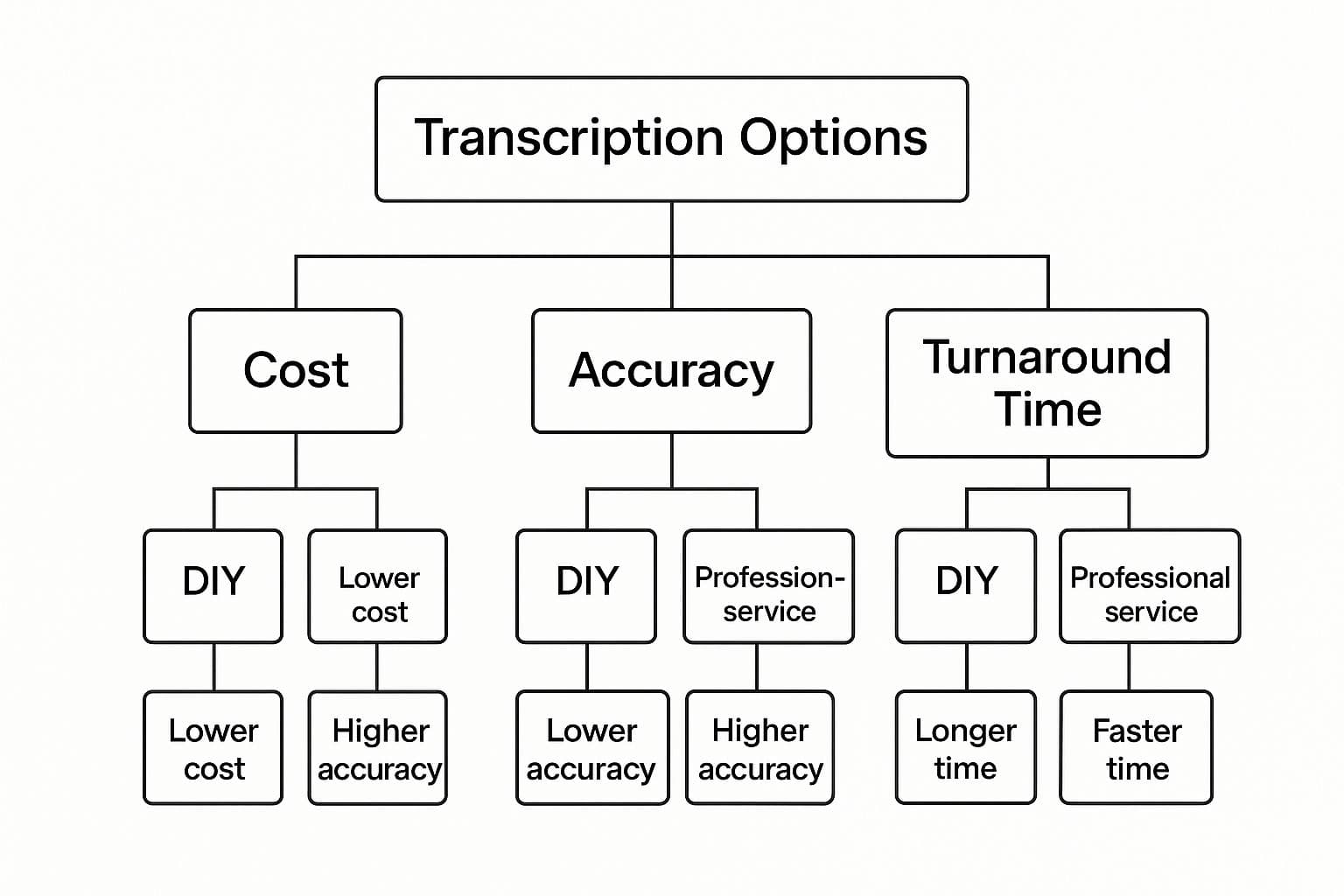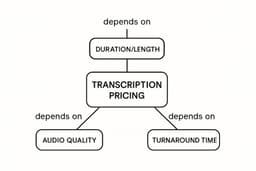So, how much should you expect to pay for a transcription service? The answer can be anywhere from less than 0.25 per minute** for an automated AI service to upwards of **5.00 per minute for a highly specialized human expert.
The final price tag really boils down to one thing: how much accuracy and expertise your project truly needs.
Why Do Transcription Costs Vary So Much?
Think of it like choosing a restaurant. An AI service is the fast-food joint of the transcription world—it’s super quick, cheap, and perfectly fine for simple, everyday needs. But for something more important, like a legal proceeding or a medical dictation, you need the fine-dining experience. That’s where a specialized human service comes in, offering precision and a flawless result you can count on.
The key is matching the service to the job. It’s not just about turning audio into text; it’s about understanding the level of detail and context required. A basic AI transcript might work for your personal notes, but it will likely fall short when dealing with:
- Multiple speakers talking over each other
- Thick accents or niche industry jargon
- Poor audio quality with lots of background noise
- The need for a true verbatim record, capturing every "um" and pause
This is where a human touch makes all the difference. A professional what a transcriptionist does is trained to decipher these complexities and deliver a polished, accurate document.
At the end of the day, the price you pay reflects the value you place on accuracy. For casual use, a cheap automated service is a no-brainer. But for professional, legal, or published content, investing in a high-quality human service is your best bet to avoid costly mistakes and get a final transcript that's reliable and ready to go.
Choosing Between Human and AI Transcription
The biggest single decision you'll make—and the one that most impacts your final bill—is choosing between an AI engine and a human professional. It’s a bit like the difference between an automated car wash and a meticulous hand-detailing service. Both get your car clean, but the results, attention to detail, and price tag are in completely different leagues.
AI transcription is your automated car wash. It's incredibly fast, super affordable, and gets the basics done with surprising efficiency. If you have a clean audio recording of a single person talking, like a solo podcast or a simple lecture, an AI transcript is often more than good enough for making notes or drafting content.
On the other hand, human transcription is the professional detailer. A real person can pick up on nuance, context, and tricky audio situations that still trip up the smartest algorithms. They can tell who's talking when people speak over each other, decipher thick accents, and make sense of recordings with a lot of background noise.

When to Save Money with AI
Going with AI is a smart move when you don't need a flawless transcript. The speed and low cost make it perfect for projects where you just need to capture the core of the conversation without breaking the bank.
Consider using an AI-powered service for things like:
- Internal Meeting Notes: You get a quick, searchable record of what your team talked about.
- First Drafts: It generates a rough text that you or your team can then clean up and edit.
- Simple Audio: It works great for clear, single-speaker recordings without much background chatter.
The technology is getting better all the time. The AI transcription market was valued at about 4.5 billion** in 2024 and is projected to jump to nearly **19.2 billion by 2034. That growth is driven by algorithms that can now hit up to 99% accuracy in perfect conditions.
When to Invest in Human Expertise
Even with all of AI's advancements, some situations just demand a human touch. In many professional fields, accuracy isn't just nice to have—it's critical. The cost of a single mistake can easily outweigh any money you saved by using an automated tool.
You should always go with a human transcriber for:
- Legal Proceedings: Court hearings, depositions, and interviews where certified accuracy is required.
- Medical Dictation: Patient records and doctor's notes where precision is vital for proper care.
- Complex Group Discussions: Think focus groups or board meetings filled with overlapping voices and technical jargon.
- Poor Quality Audio: Any recording with lots of background noise, echoes, or muffled speakers.
Ultimately, the debate over whether AI is better than regular transcription boils down to what you need. Take a hard look at your audio quality, how accurate the final text needs to be, and what your budget allows. For anything high-stakes, investing in a human expert gives you peace of mind and a result you can count on.
What Really Drives Up Your Transcription Bill?
Ever sent the same audio file to two different transcription services and gotten back two completely different price quotes? It's a common experience, and it's because the length of your audio is only the starting point. The real cost drivers are hidden in the details of the recording itself.
Think of it like hiring someone to paint a room. A clean, empty room with smooth walls is a simple, predictable job. But if that same room has towering ceilings, old paint to scrape off, and is crammed with furniture that needs to be moved and covered, the price is going to jump. It’s the same with transcription—the more complex the job, the higher the cost.
Poor Audio Quality is the Biggest Culprit
If there’s one thing that will inflate your transcription costs more than anything else, it's poor audio quality. Simple as that.
When a transcriber has to constantly hit rewind, strain to hear muffled words, or try to pick out speech from a sea of background noise, their work slows to a crawl. A file that should have taken one hour to transcribe can easily stretch into three or four hours of painstaking work.
Here are the most common audio problems that will cost you:
- Background Noise: The chatter in a coffee shop, the drone of an air conditioner, or passing street traffic can easily swallow up words.
- Low Volume: If people are too far from the mic, their voices become faint and incredibly difficult to decipher.
- Echoes and Reverb: Recording in a big, empty room creates an echo that turns clear speech into a muddy mess.
- Technical Glitches: Things like static, electronic humming, or digital artifacts from a bad connection can make an audio file almost unusable.
The bottom line? A clean, crisp recording is your best friend for keeping costs down. Always do a quick test recording in a quiet spot before you start for real.
The People on the Recording Matter, Too
Beyond the technical quality, the speakers themselves play a huge part in determining the final price. A straightforward one-on-one interview is a breeze to transcribe compared to a chaotic group discussion where everyone is talking at once.
This is a perfect example of a more complex scenario, taken from a Wikipedia page on transcription.

You can see how just having multiple people speaking adds a whole new layer of work. The transcriber now has to carefully identify who is saying what.
Other speaker-related factors that add to the cost include:
- Multiple Speakers: The more voices in the mix, the harder it is to keep track of the conversation.
- Cross-Talk: When people talk over one another, it takes a skilled ear to untangle the overlapping dialogue.
- Heavy Accents: Unfamiliar accents or strong regional dialects can be tough for a transcriber to understand, often requiring more time or even a specialist.
- Fast Talkers: People who speak a mile a minute force the transcriber to slow down the audio and listen over and over again, which adds significant time to the project.
Special Requests and Tight Deadlines
Finally, the specific requirements of your project can bump up the price. A standard transcript is one thing, but if you need extra features or a super-fast turnaround, expect the cost to reflect that.
Other special requests that add to the bill are:
- Verbatim Transcription: Do you need every single "um," "uh," stutter, and false start captured? This is far more time-consuming than creating a clean, edited transcript where those filler words are removed.
- Timestamping: Adding time codes at specific intervals (like every 30 seconds or every minute) is an extra manual step that takes time and precision.
- Technical Jargon: If your audio is full of dense medical, legal, or industry-specific terms, you'll likely need a transcriber with expertise in that field. That specialized knowledge comes at a higher rate.
By understanding what drives the cost of transcription services, you're in a much better position to control your budget. Preparing your audio thoughtfully can make a huge difference, leading to a more accurate transcript and a much more affordable result.
How Transcription Services Figure Out Your Bill
If you want to find the best deal on transcription, you first have to get a handle on how these companies actually charge you. While the final price tag can vary a lot, the way they calculate it is usually pretty consistent across the board. Once you understand the pricing models, you can compare apples to apples and avoid any nasty surprises on the final invoice.
The most common model you'll see is per audio minute. It's the industry standard for a good reason—it’s simple and predictable. If you have a 60-minute recording, you pay for 60 minutes of transcription. Easy. This lets you figure out your cost right from the start, which is a huge help for budgeting.
But that’s not the only way companies do it. You'll run into other pricing structures, often designed for specific types of projects or industries.
Common Pricing Models Explained
So, let's look at the main ways transcription services might price their work. While paying by the minute is king, knowing the alternatives helps you pick the right service for your specific job.
You might also find services that charge:
- Per Word: This isn't as common for general transcription, but it pops up when the final word count is what really matters, not the length of the recording.
- Per Line: You'll see this a lot in the medical and legal fields. In that world, a "line" is often a specific unit of measurement (like 65 characters), and documents have a standard format, making this a logical way to bill.
- Per Hour: This is usually reserved for the really tough jobs. Think about restoring a damaged old recording or transcribing a chaotic meeting with people shouting over each other. It’s for work that takes a ton of manual effort beyond just typing.
The image below really drives home the trade-off you're making between a cheaper, do-it-yourself approach and hiring a professional, which is directly tied to how these services are priced.

As you can see, you pay more for a professional service because you're buying their accuracy and speed. This is exactly why their pricing is built around the value they deliver, not just the raw time spent.
Comparing Different Structures
To give you a clearer picture, let's break down these models side-by-side.
Comparing Transcription Pricing Models
Here’s a quick overview of the common pricing structures you'll encounter, what they're best for, and what to watch out for.
| Pricing Model | How It Works | Commonly Used For |
|---|---|---|
| Per Audio Minute | You pay a flat rate for every minute of audio, regardless of how much talking there is. | The vast majority of projects: interviews, podcasts, webinars, meetings, academic research. |
| Per Word | The final cost is based on the total number of words in the finished transcript. | Specialized projects, translation, or when the final document's length is the key metric. |
| Per Line | Billing is based on a defined "line" (e.g., 65 characters), common in formatted documents. | Medical and legal transcription where standardized document formats are the norm. |
| Per Hour | You pay for the transcriber's actual work time, not the audio length. | Highly complex or poor-quality audio that requires significant extra effort and time to decipher. |
Ultimately, the best model really depends on your audio file. For a fast talker who crams tons of words into a minute, a per-minute rate will almost always be cheaper than paying per word. On the flip side, if your audio has long, silent gaps, paying by the word could actually save you money.
When you get a quote, always double-check how they're charging. A rate of $0.10 might look like a steal, but if that’s per word instead of per minute, a dialogue-heavy 10-minute file could get expensive fast. Knowing these details puts you in control, so you can ask the right questions and pick a service that truly fits your needs and budget.
Here is the rewritten section, designed to sound completely human-written and natural.
Why Specialized Transcription Costs More
When you get into specialized fields like law, medicine, or academic research, a standard, one-size-fits-all transcript just won't cut it. The cost of transcription services for these areas is higher for a simple reason: you're not just paying for someone to type out words. You're paying for deep expertise, ironclad security, and a document that can hold up in court.
Think of it like hiring a mechanic. Any decent garage can handle a routine oil change. But if you need to rebuild the engine on a high-performance sports car, you’re going to a specialist who has the right training and tools. That level of skill costs more, and it's the exact same deal with transcription.
The Need for Subject Matter Experts
In highly specific fields, context is everything. A general transcriber might hear a doctor say "mitral valve prolapse" and type "my trial valve pro labs." Phonetically, they're close, but the medical meaning is completely lost. An error like that in a patient's record could have disastrous consequences.
To prevent these kinds of critical mistakes, specialized services use transcribers who are also subject matter experts. These aren't just fast typists; they're professionals who actually understand the jargon, acronyms, and subtle nuances of their field. This ensures the final document isn't just a transcript, but an accurate interpretation of the conversation. Finding people with this dual skill set means tapping into a much smaller, more qualified talent pool, which naturally drives up the cost.
Strict Formatting and Legal Requirements
It’s not just about getting the words right, either. Many specialized fields demand transcripts that follow very specific, rigid formatting rules. A legal deposition, for example, isn't just a typed-out conversation. It's a formal, court-ready document with a specific layout, numbered lines, and certifications that make it admissible as evidence.
In the same way, academic researchers often need their transcripts formatted in a particular style, like APA or MLA, for their qualitative analysis. This painstaking, detail-oriented work takes a lot of time and specialized training, adding to the overall cost.
- Legal Transcription: Requires precise speaker identification, time-stamping, and often a signed certificate confirming its accuracy.
- Medical Transcription: Must follow strict templates for patient records, clinical summaries, and SOAP notes.
- Academic Transcription: Can involve detailed notes on non-verbal cues, pauses, and emotional tone, which are vital for research.
Compliance and Confidentiality Mandates
Finally, industries like healthcare and law are built on a foundation of trust and confidentiality. This means transcription providers have to invest heavily in security and compliance to protect incredibly sensitive data. For any medical work, this means airtight adherence to HIPAA (Health Insurance Portability and Accountability Act) to protect patient privacy. Legal transcriptionists are similarly bound by strict confidentiality agreements.


